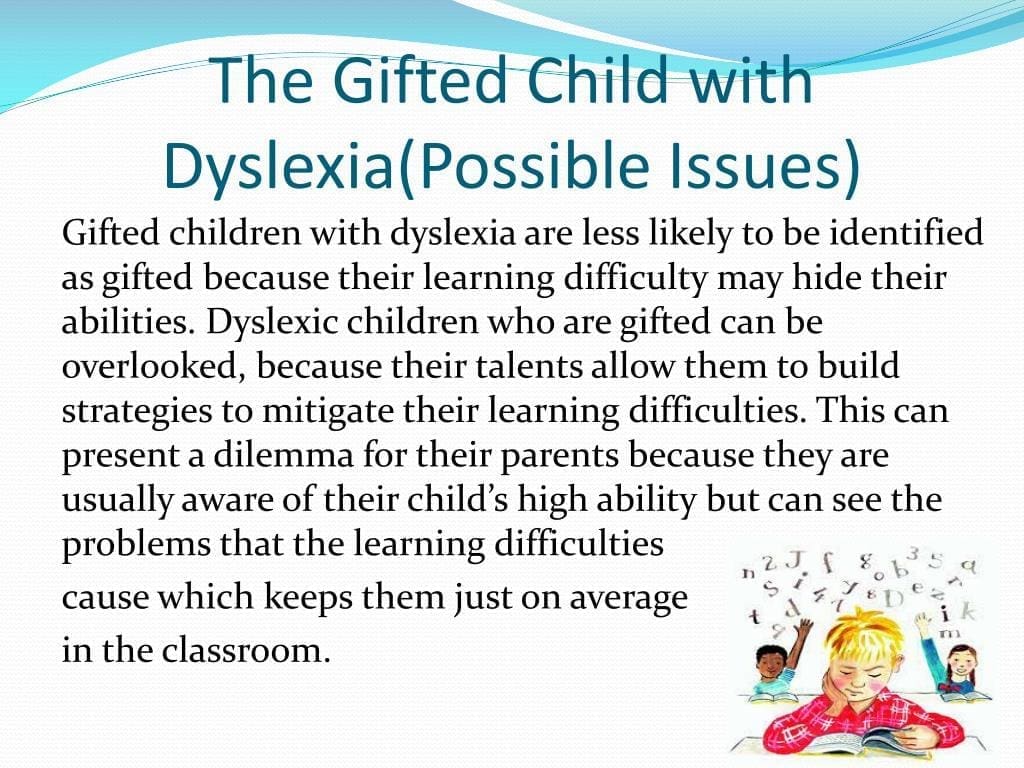
Gifted kids can be dyslexic too!
In the Facebook group Parents of Gifted and High Ability Children, a mom asked, “Anyone here have a gifted + ADHD+dyslexia kid? Is this even possible?”
Not only is it possible, but a large percentage of gifted kids, especially spatially gifted kids, are dyslexic (often without their parents and teachers even knowing.) In fact, according to Dyslexia Awareness, “Over 50% of NASA employees are reported as dyslexic. They are said to be deliberately sought after because they have superb problem-solving skills and excellent 3D and spatial awareness. Dyslexics are over represented in the top ranks of people who are unusually insightful, who bring a new perspective, who think out of the box.”
The blog also says, “Whereas the average person summons around 150 images per second, the dyslexic can muster from 1500 to 4000 images per second. But the fact that this can also be done on a three dimensional basis makes the dyslexic skill set very special indeed.”
Strengths of Dyslexics
Sally Shayman in her excellent book Overcoming Dyslexia lists some of the strengths of someone with dyslexia as:
- Curiosity
- Great imagination
- Ability to figure things out
- Ability to get the big picture
- Eager embrace of new ideas
- Good understanding of new concepts
- Surprising maturity
- Large vocabulary
- Enjoys solving puzzles
- Talent for building models
- Excellent comprehension when listening to stories
- Excellent thinking skills
- Exceptional empathy
Don’t these sound like characteristics we think of in gifted children? However, parents and teachers often overlook dyslexia in gifted children. The reason, according to the Davidson Institute For Talent Development: “these children are able to use strong higher-order language skills to compensate for the low-level deficits in auditory and visual processing that cause the reading problems in dyslexia. As a result, they are able to read with relatively good comprehension.” Davidson actually came up with their own term, stealth dyslexia.

My Own Experience
My passion for teaching math in new ways actually started with a training course to become a dyslexia specialist. he trainer told us that current brain research indicated that a full 20 percent of children use completely different neural pathways to read and could be considered dyslexic. “ In college 20 years earlier I had learned that less than 10 percent of students should be considered special needs. If a full 20 percent could be considered dyslexic, was that then actually a learning disability, or a very common learning DIFFERENCE?
As I continued to learn, I was amazed. The trainer held up a watch. “This is a watch,” he said. “Whether I turn it upside down, right side up, or to either side it’s still a watch. That’s how the world works. But letters are different. It’s not that dyslexics see them backwards. It’s that a b, d, p, and q are all the same thing, just rotated differently, and a dyslexic child sees all the possibilities in 3D.”
I immediately after hearing that made time to talk to a severely dyslexic student that I worked with. “Do you see letters in 3D?”
He looked at me funny and then said, “No one has ever asked me that before, but yes!”
It rocked my world. However, the implications for reading had already been widely studied. It was clear from the research that dyslexic kids needed systematic phonics instruction. I was fascinated by the much lesser studied math implications.
Soon after, I took a job as the program director of a math learning center specializing in right brain methods to teach math. I saw kids come in because they were struggling with the way they had learned math in school. However, when I showed them math as patterns and taught them through geometric concepts (such as using perimeter for addition and area for multiplication), they turned out to be highly gifted complex thinkers.
On the other side there were kids who did perfectly well in school and had such highly developed compensation skills their parents had no idea they were dyslexic.
Here are some clues your gifted child might be dyslexic:
- Your gifted child may have very high reading comprehension, but listen to them read orally. Do they skip words, word endings, or whole lines of text? Do they substitute different words?
- Do they show comprehension of long texts or books but have difficulty answering questions about short passages, especially in a multiple choice format?
- If you give them a “nonsense” (made up word) can they pronounce it by using phonics? Do they know phonetic rules or did they learn to read by sight and have trouble with words they have never seen before?
- Does your child only want to read within an area of specialized interest?
- Do they have trouble telling if words rhyme?
- Do they have trouble with spelling? (They may do OK on tests, but have a lot of trouble spelling in their own writing)
- Will they tell you things orally but hate having to write them down? Do they have “lightning fast” thoughts but trouble organizing them? (Dysgraphia is very often found in kids with “stealth dyslexia.” As Davidson Institute says, “Even extremely precocious adolescents with outstanding oral language skills, remarkable knowledge bases, and extremely lively minds can produce written documents of such brevity and simplicity that they look as if they’d been written by a struggling third grader.”)
- Do they have poor hand eye coordination?
So what do “stealth dyslexics” need?
According to Understood.org’s article “What is Stealth Dyslexia?” these gifted students require the same supports as other dyslexic students:
- Instruction in phonemic awareness and phonics, where progress is based on decoding ability, not comprehension
- Text-to-speech readers, especially for long reading assignments
- A good keyboarding program to help with spelling and writing
- Extra time on tests
- Individualized expectations for writing”
But what about resources for math, since that’s the focus on my site? See my post Dyslexia in Math and Dyscalculia.
Advocating For Your Gifted Child
A gifted student’s parents may need to fight for them to get the testing they need to qualify for school programs. Teachers sometimes do not suspect dyslexia if a child is performing well in school, yet they need to know gifted kids can be dyslexic too! If your child is a student at a public school in the United States, submit a written request for an evaluation for a specific learning disability in reading – decoding and written language. Legally, the school must either test or provide prior written notice for why they are refusing. If they refuse to test, you have rights to hearing or mediation. Private options include neuropsychological testing by a neuropsychologist, psychologist, or educational diagnostician.
However, if you homeschool you don’t need any testing. I always tell parents, the strategies that help dyslexic children are not harmful to any child! If your child shows signs of dyslexia, teach them with strategies proven to help dyslexic students. In future posts I will talk more about these for math.
